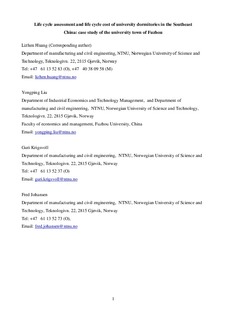| dc.contributor.author | Huang, Lizhen | |
| dc.contributor.author | Liu, Yongping | |
| dc.contributor.author | Krigsvoll, Guri | |
| dc.contributor.author | Johansen, Fred | |
| dc.date.accessioned | 2017-11-21T14:18:00Z | |
| dc.date.available | 2017-11-21T14:18:00Z | |
| dc.date.created | 2017-06-12T11:57:04Z | |
| dc.date.issued | 2017 | |
| dc.identifier.citation | Journal of Cleaner Production. 2017, 2017 . | nb_NO |
| dc.identifier.issn | 0959-6526 | |
| dc.identifier.uri | http://hdl.handle.net/11250/2467399 | |
| dc.description.abstract | The aim of this paper is to assess university dormitories in terms of life cycle environmental impact and cost, as part of the university campuses sustainable development in southeast China. This life cycle assessment follows the ISO 14040/44 methodology, considering the construction, operation, maintenance and demolition stages. The reference unit of this study is defined as ‘one useful square meter university dormitories with 50 years life time’. This study estimates the life cycle inventory by: 1) tenders information of university dormitories built in the university town of Fuzhou during 2007–2011, 2) water and energy bills of those building over past 5 years, 3) damage and maintenance report of dormitories in Fuzhou University and Fujian University of traditional Chinese medicine during 2004–2014. The Ecoinvent database provides the background data to the analysis.
The results indicate that 1) the use stage, including operation and maintenance is the dominate part of the life cycle environmental impacts and cost of university dormitories. 2) The consumption of electricity constitutes the main elements causing the environmental impacts over the life cycle of university dormitories. The technology for more energy efficient building is more important than other factors. 3) The window, concrete, steel, and cement have the largest contribution to the embodied environmental impacts but with the relative small contribution to the life cycle cost. Therefore, two main improving opportunities for reducing the environmental impacts of Chinese university dormitories development are identified: 1) improving building with deep renovation for current dormitories and implementing low energy buildings standards for new built dormitories the buildings energy efficiency and 2) increasing the use of low environmental impacts building material by implementing the carbon tax on main building material and introducing timbers as structure material. Moreover, policies to promote the more renewable energy supply and the implementation of carbon capture and storage technology constitute another import issue. | nb_NO |
| dc.language.iso | eng | nb_NO |
| dc.publisher | Elsevier | nb_NO |
| dc.rights | Attribution-NonCommercial-NoDerivatives 4.0 Internasjonal | * |
| dc.rights.uri | http://creativecommons.org/licenses/by-nc-nd/4.0/deed.no | * |
| dc.title | Life cycle assessment and life cycle cost of university dormitories in the southeast China: Case study of the university town of Fuzhou | nb_NO |
| dc.type | Journal article | nb_NO |
| dc.type | Peer reviewed | nb_NO |
| dc.description.version | acceptedVersion | nb_NO |
| dc.source.pagenumber | 9 | nb_NO |
| dc.source.volume | 2017 | nb_NO |
| dc.source.journal | Journal of Cleaner Production | nb_NO |
| dc.identifier.doi | 10.1016/j.jclepro.2017.06.021 | |
| dc.identifier.cristin | 1475360 | |
| dc.description.localcode | © 2017. This is the authors’ accepted and refereed manuscript to the article. LOCKED until 4.6.2019 due to copyright restrictions. This manuscript version is made available under the CC-BY-NC-ND 4.0 license http://creativecommons.org/licenses/by-nc-nd/4.0/ | nb_NO |
| cristin.unitcode | 194,18,25,30 | |
| cristin.unitcode | 194,18,25,21 | |
| cristin.unitname | Seksjon for bygg, geomatikk og realfag | |
| cristin.unitname | Seksjon for elektro og maskin | |
| cristin.ispublished | true | |
| cristin.fulltext | postprint | |
| cristin.qualitycode | 2 | |

